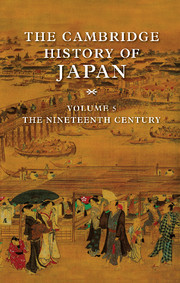Book contents
- Frontmatter
- Introduction
- 1 Japan in the early nineteenth century
- 2 The Tempō crisis
- 3 Late Tokugawa culture and thought
- 4 The foreign threat and the opening of the ports
- 5 The Meiji Restoration
- 6 Opposition movements in early Meiji, 1868–1885
- 7 Japan's turn to the west
- 8 Social change
- 9 Economic change in the nineteenth century
- 10 Meiji political institutions
- 11 Meiji conservatism
- 12 Japan's drive to great-power status
- Works Cited
- Index
- References
10 - Meiji political institutions
Published online by Cambridge University Press: 28 March 2008
- Frontmatter
- Introduction
- 1 Japan in the early nineteenth century
- 2 The Tempō crisis
- 3 Late Tokugawa culture and thought
- 4 The foreign threat and the opening of the ports
- 5 The Meiji Restoration
- 6 Opposition movements in early Meiji, 1868–1885
- 7 Japan's turn to the west
- 8 Social change
- 9 Economic change in the nineteenth century
- 10 Meiji political institutions
- 11 Meiji conservatism
- 12 Japan's drive to great-power status
- Works Cited
- Index
- References
Summary
The overthrow of the Tokugawa in 1867–68 carried implications of important changes in the political institutions of Japan, as well as in the location of power. Yet when Tokugawa Yoshinobu (Keiki) resigned as shogun in November 1867, this did not seem by any means inevitable. He might well have been succeeded, so contemporaries believed, by some kind of baronial council, in which he would still hold a preponderant place, thereby putting the authority of the shogun into the hands of a group of great lords, of whom he would be one. The palace coup d'état of January 3, 1868, engineered by Satsuma and Chōshū, ended that prospect, at least in the sense of ensuring that the Tokugawa would be excluded from any successor regime to which those domains belonged. There followed some months of civil war, which confirmed and extended Japan's political polarization, ensuring that all the lords and most of their retainers had to commit themselves to one side or the other. After this there was no going back. Because the Tokugawa had been defeated and there had emerged no single victorious feudal lord who could aspire to the office of shogun – Satsuma came closest – the country's new rulers had then to work out an alternative framework through which authority could be exercised. Japanese tradition and recent history ensured that it must focus on the emperor, but devising institutions appropriate to it was to take a whole generation, that is, until the promulgation of the constitution in 1889 and the associated regulations concerning central and local government.
- Type
- Chapter
- Information
- The Cambridge History of Japan , pp. 618 - 673Publisher: Cambridge University PressPrint publication year: 1989
References
- 7
- Cited by

